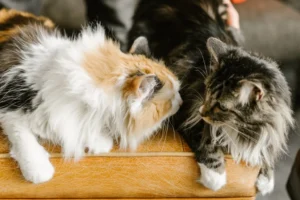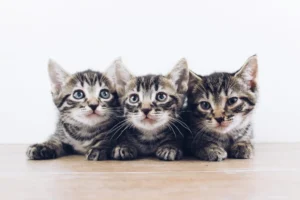Have you ever wondered why cats cross tails with each other? It’s a common behavior among felines that can be both mysterious and endearing. In this blog post, we’ll explore the reasons behind this quirky habit and shed some light on why cats engage in this unique form of communication.
Cats cross tails as a way to communicate and bond with one another. This behavior is often seen between cats who have a close relationship, such as littermates or lifelong companions. By intertwining their tails, cats are able to exchange scents and pheromones, marking each other as a part of their social group. This ritual helps strengthen their connection and reinforces their sense of belonging within the group.
How do cats use their tails to communicate?
Cats are masters of non-verbal communication, and their tails play a crucial role in expressing their emotions and intentions. A cat’s tail can be like a mood ring, giving you insight into how they’re feeling at any given moment. For example, an upright tail with a slight curve at the tip usually signifies a content and happy cat, while a puffed-out tail indicates fear or agitation.
Tail flicking is another common behavior that can signal annoyance or excitement. A rapid flicking of the tail can indicate irritation, while a slow and deliberate swish might mean they’re getting ready to pounce on a toy or prey.
Tail wrapping is a behavior where a cat will gently wrap its tail around another cat, human, or even an object. This is often a sign of affection and can be a way for them to show comfort and closeness to their companion.
Piloerection , or when a cat’s fur stands on end along their tail, is a clear sign of aggression or fear. It’s their way of appearing bigger and more intimidating to potential threats.
Understanding these subtle cues can help you better communicate with your feline friend and strengthen your bond with them.
Is tail crossing a form of greeting?
While tail crossing may seem like a simple movement, it actually holds significant meaning in feline communication. When two cats cross tails, it is often a sign of camaraderie and trust between them. It’s like a secret handshake among feline friends, symbolizing their close relationship and shared bond.
In some cases, tail crossing can also serve as a way for cats to transfer their scent onto each other, essentially marking each other as part of the same social group. This scent-sharing behavior helps establish a sense of unity and familiarity within a group of cats.
Next time you see cats crossing tails, remember that it’s not just a random gesture – it’s a meaningful expression of their connection and friendship.
Additional Insight: The Direction of Tail Crossings
Interestingly, the direction in which cats cross their tails can also hold significance. When cats cross tails in an overlapping manner, with one tail positioned over the other, it can indicate a hierarchy within a group of cats. The cat whose tail is on top may be asserting dominance or control over the other cat. On the other hand, parallel tail crossings, where both tails are aligned side by side, can signify a more equal or harmonious relationship between cats. Paying attention to these subtle details can offer valuable insights into the dynamics of cat interactions.
Why do cats only cross tails with certain cats?
Cats are known for being selective creatures, and this behavior extends to their tail-crossing habits. When cats engage in tail crossing with another feline, it can signify trust, familiarity, and a social bond. Just like humans choose their friends carefully, cats also tend to be particular about which cats they engage in this behavior with. Factors influencing their choices may include mutual trust, social hierarchy within a group of cats, and compatibility in personalities.
Some cats may only cross tails with their siblings or littermates, reinforcing the bond established from a young age. Others may choose to engage in this behavior with cats they have known for a long time, indicating a deep and enduring connection. Cats may also be selective based on their comfort level with other cats, preferring to interact in this way with those they feel safe and relaxed around.
Interestingly, cats may also be more likely to cross tails with cats they view as equals or friends, further solidifying their social relationships within their feline community. Observing which cats a feline chooses to engage in tail crossing with can provide valuable insights into their social dynamics and relationships within a multi-cat household.
Do different tail positions hold different meanings?
During tail crossing interactions, the positioning of a cat’s tail can convey nuanced messages and emotions. Understanding these signals can help decipher the nature of the interaction between cats. For instance, when cats cross tails with their tails held high, it often indicates confidence, happiness, and a positive social bond. This high-tail position signifies a harmonious and friendly encounter between the felines.
Conversely, if a cat’s tail is tucked between its legs while engaging in tail crossing, it may signal fear, anxiety, or submission. This lower-tail position suggests a more cautious or vulnerable interaction between the cats involved. Observing the tail positions of cats during tail crossing can provide valuable insights into their emotional state and the nature of their relationship at that moment.
Additionally, a cat may also use its tail to communicate dominance or assertiveness during tail crossing interactions. A cat with an upright, slightly puffed tail may be signaling its confidence and authority within the social group. Paying attention to the subtle cues of tail positions can enhance our understanding of cat behavior and improve our ability to interpret their communication with one another.
Tip: When cats engage in tail crossing, pay close attention to the positioning of their tails to gain a deeper understanding of their emotions and the dynamics of their social interactions.
Can cats from different households engage in tail crossing?
Cats from different households can indeed engage in tail crossing behavior, especially when they are familiar with each other or have formed a close bond. Tail crossing can signify a sign of friendship, trust, and camaraderie between cats, regardless of their living arrangements. It is a way for them to display social connection and comfort with one another.
In multi-cat households where the felines have established relationships, it is common to observe tail crossing as a form of communication and affection. Even cats that meet occasionally, such as during outdoor encounters or neighborhood feline friendships, may engage in tail crossing to demonstrate their amicable interaction.
While cats are known for their independence, they also form social bonds with other felines, whether from the same household or different ones. So, if you notice cats crossing tails with one another, it’s a positive sign of their relationship and comfort level with each other.
Do kittens learn to cross tails from their mothers?
Kittens do indeed learn behaviors from their mothers, and tail crossing can be one of them. Mother cats often engage in tail crossing with their kittens as a way to bond, communicate, and show affection. Kittens observe and mimic their mothers’ behaviors, including tail crossing, as a form of social learning.
Through this observational learning process, kittens pick up on various behaviors that help them navigate their surroundings and interact with other cats. Tail crossing is not only a gesture of warmth and closeness but also a way for mother cats to teach their kittens about social cues and connections within the feline world.
As kittens grow and develop, they may continue the practice of tail crossing with their littermates, other cats in the household, or even cats from different households. This learned behavior from their mothers plays a crucial role in shaping their social interactions and relationships with other felines throughout their lives.
Additional Insight: When kittens are separated from their mothers at a young age, they may miss out on important social interactions and learning experiences, such as tail crossing. This can impact their ability to form strong bonds with other cats later in life. Providing socialization opportunities and interactions with other cats can help fill this gap and support healthy feline relationships.
What role does grooming play in tail crossing behavior?
Grooming is an essential part of a cat’s social interaction and plays a significant role in tail crossing behavior. Cats groom each other to strengthen their social bonds, show affection, and establish hierarchy within their group. When cats engage in mutual grooming, they are reinforcing their relationships and forming a sense of trust and familiarity with one another.
Tail crossing often occurs during or after grooming sessions, signifying a deep level of connection between cats. It is a way for cats to further demonstrate their closeness and comfort with one another. Through grooming and tail crossing, cats are able to communicate non-verbally and maintain harmonious relationships within their social group.
Are there other forms of tail communication in cats?
In addition to tail crossing, cats use their tails in various ways to communicate with each other. Tail position, movement, and shape can all convey different messages in feline communication. For example, an upright tail indicates confidence and friendliness, while a low or tucked tail signals fear or submission. A twitching tail may indicate agitation or excitement, while a puffed-up tail suggests aggression or defensiveness.
Cats also use their tails to signal playfulness, such as when they flick their tails back and forth during interactive play. Tail waving and wrapping around another cat can be a sign of greeting or affection. By being attentive to the nuances of tail language, cat owners can better understand their pets’ emotions and intentions, strengthening the bond between them.
Additional Insight: Cats may also engage in tail fluffing, where they puff up their tails to appear larger and more intimidating when feeling threatened or challenged. This behavior is a form of self-defense and a way for cats to assert their dominance in a situation.
Alex, a passionate animal lover, has experience in training and understanding animal behavior. As a proud pet parent to two dogs and three cats, he founded AnimalReport.net to share insights from animal experts and expand his knowledge of the animal kingdom.









